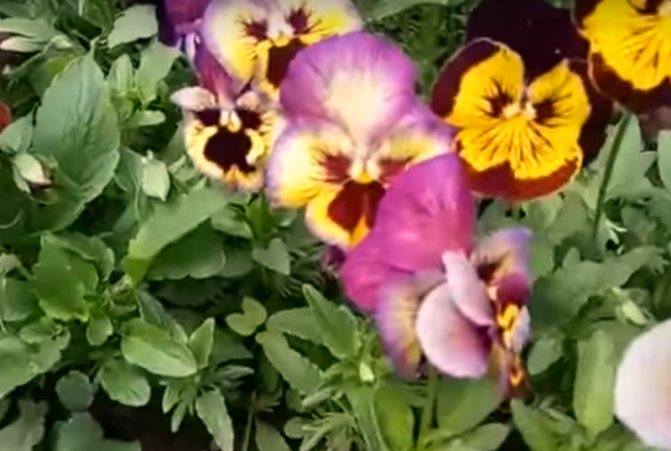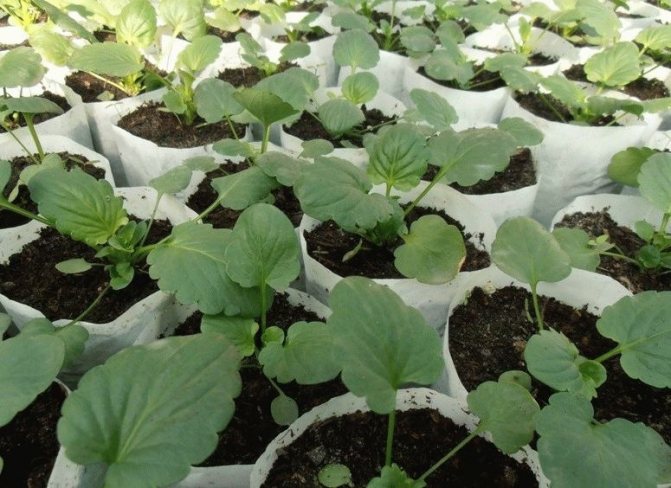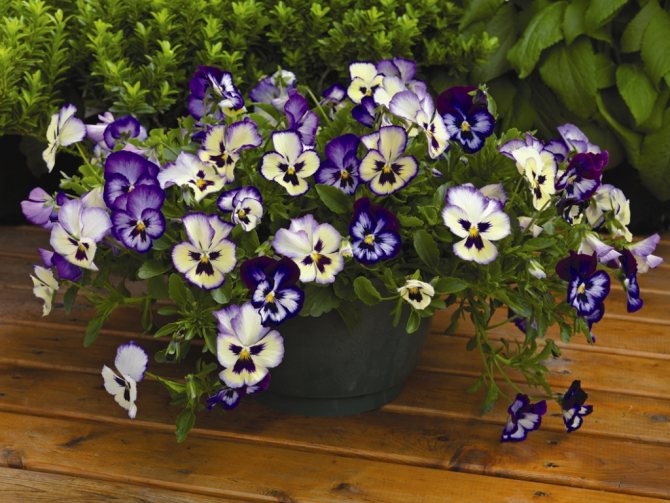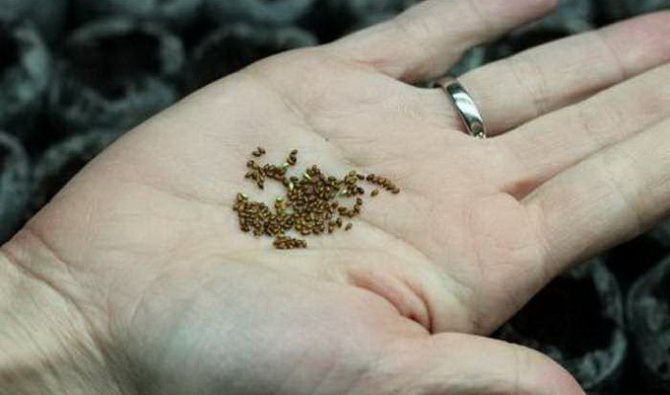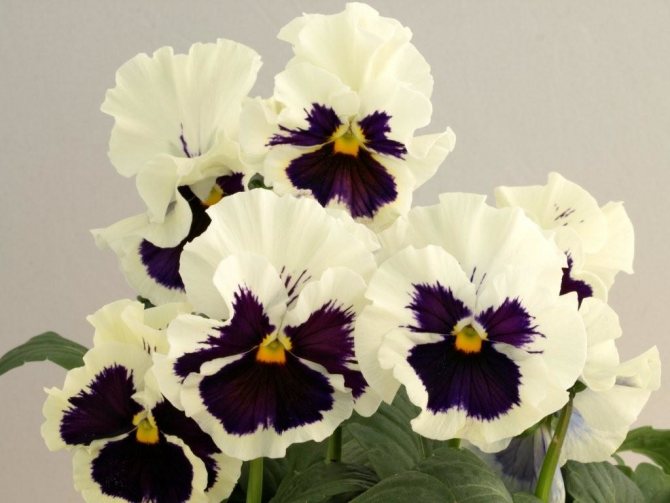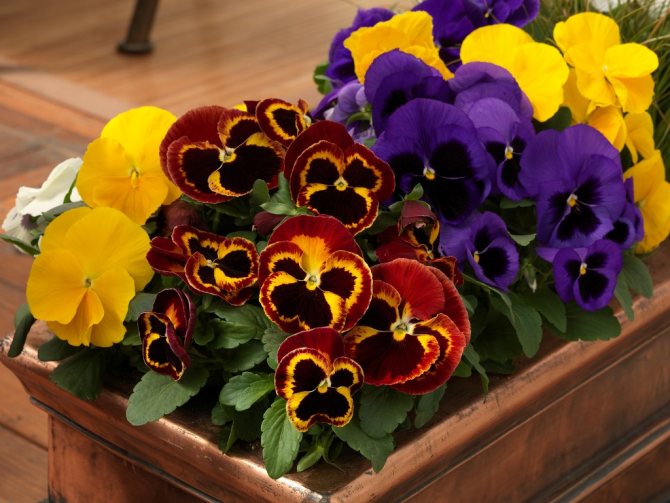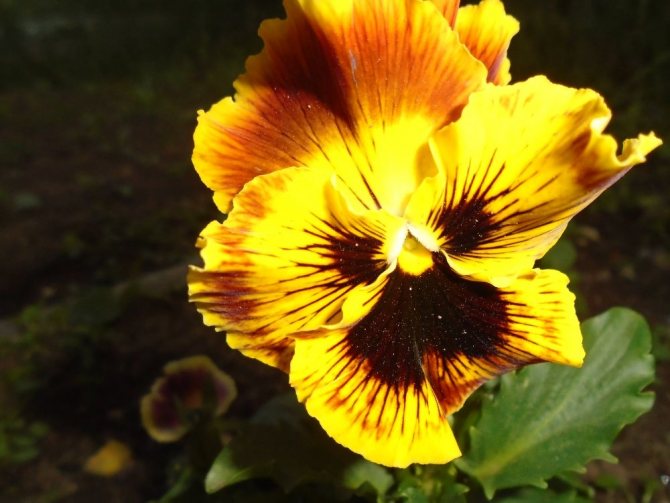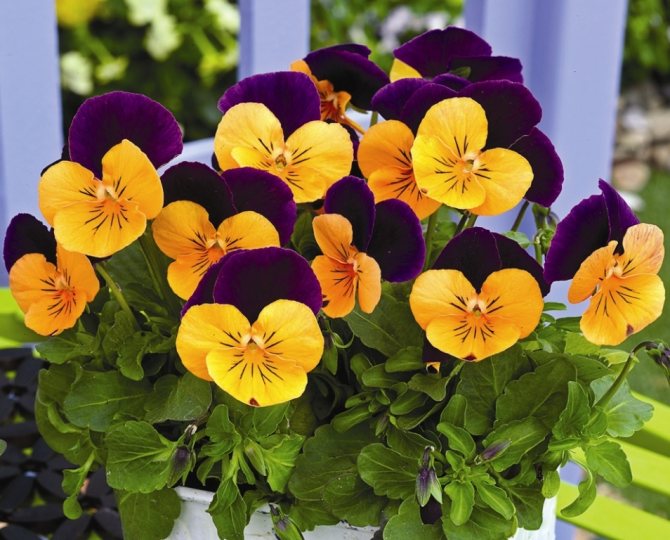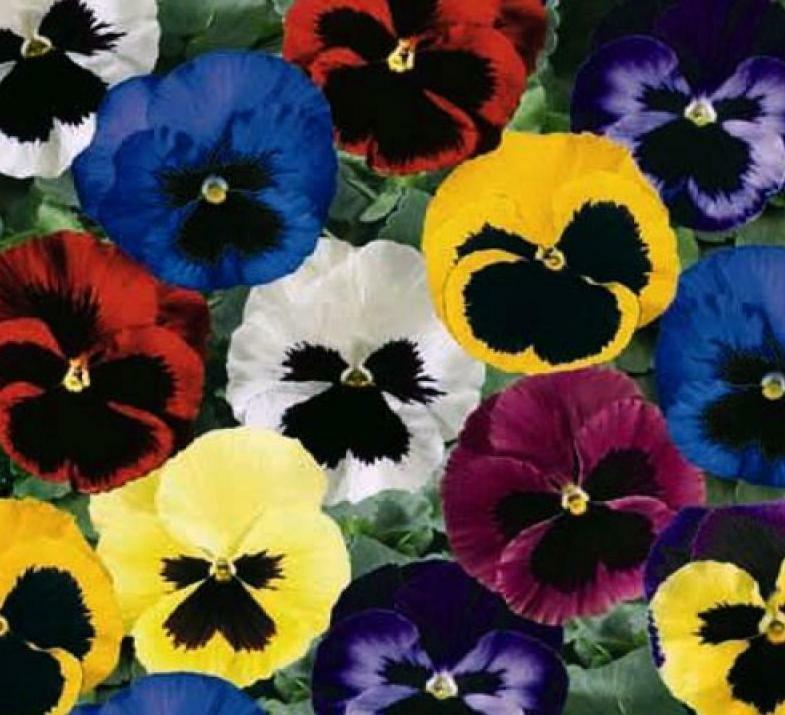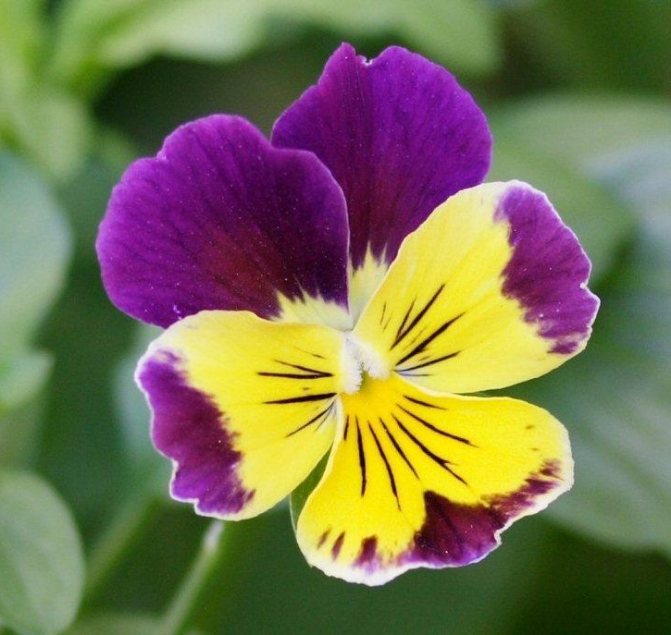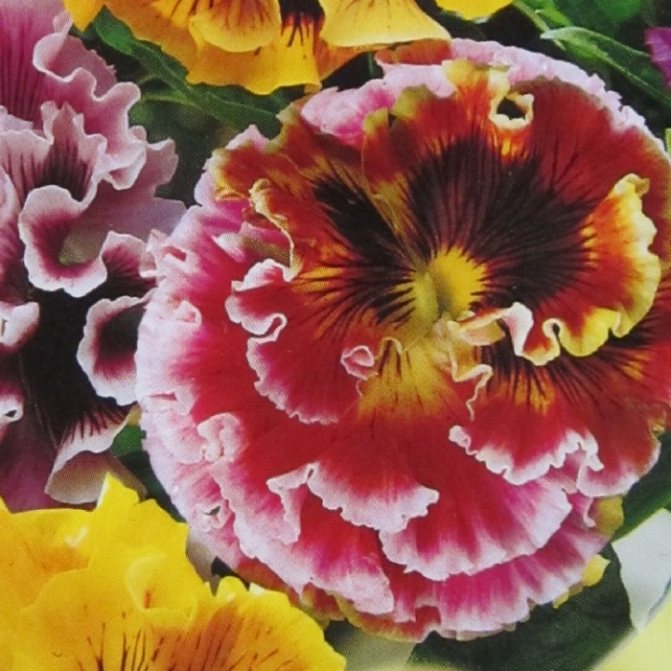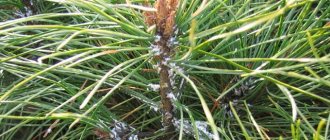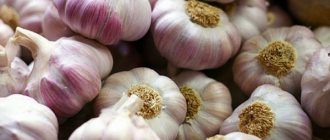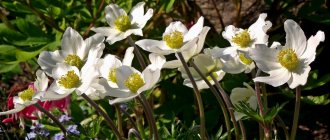
The bright beauty viola, she is also called pansies and violets, will decorate any flower bed. Viola is easy to grow and propagate. The seeds of the plant can be sown directly into the heated soil. For a long flowering viola with brighter and larger flowers, the grower will have to follow several rules. Let's take a closer look at this plant, talk about the features of planting and care in the open field.
Viola features
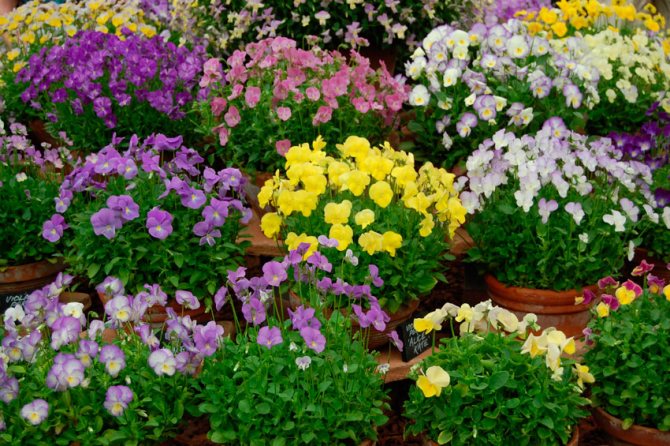

Viola representatives can be annuals, biennials and perennials. Such a herbaceous plant reaches a height of 15-30 centimeters. The root system is fibrous, the main stem is erect. Leaf plates with stipules can be pinnately dissected or simple. They grow alternately or are part of the root rosette. Single axillary flowers, reaching 7 centimeters in diameter, are located on rather long peduncles. The petals located at the top are with marigolds, and at the bottom they are larger and have a saccular formation (spur) located at the base. The shape of the flowers and color can be very different, for example: two- or three-colored, monochromatic, striped, spotted, with 1 spot, with an even or wavy edge of the petals, double or simple, etc. The flowering of this plant is incredibly abundant. Depending on when the plant was planted, flowering can be observed from the second half of March to the end of the spring period, or from August to the very frost. There are hybrids that bloom throughout the summer period or 2 times per season. The fruit is a box with seeds inside. Their high germination capacity is maintained for a couple of years.
It is a frost-hardy plant that does well in the shade. However, in a shaded place, its flowering is less abundant, while the flowers themselves become smaller. Loamy, moist soil rich in nutrients is best suited for planting. If you plant such a flower on dry sandy soil, then as a result of this, the flowers will also become smaller.
When to sow seeds
Florists recommend starting sowing in late February or early March. During this time, there is enough natural light for the plants to develop normally.


Note! You can sow viola seeds in several stages. Even sowing in May will not be superfluous. As a result, the plants will delight with their flowering until the end of summer, decorating the flower bed with bright colors.
Growing viola from seeds
Sowing seedlings


Sowing seeds can be done directly into open soil. However, the most popular and reliable way to grow viola is through seedlings. If sown in the last days of February, then such plants will bloom already in the current year. For sowing, it is recommended to purchase a special soil mixture for violets, while the seeds must be immersed in a solution of zircon or epin for 24 hours. Make grooves in the substrate and add pre-dried seeds to them. Sprinkle them with soil, which is previously rubbed between the palms. Next, watering is carried out, and the container is covered with film or glass. Then the container must be removed to a cool enough place (about 15 degrees).
Seedling


The first seedlings will appear after 7-10 days. As soon as this happens, the shelter will need to be removed, and the container moved to an even cooler place (about 10 degrees). Lighting must be bright, but diffused, while flowers must be protected from direct sunlight. Seedlings need to be watered and fed in a timely manner. In this case, feeding is carried out once every 2 weeks using a solution of complex mineral fertilizer.
Picking
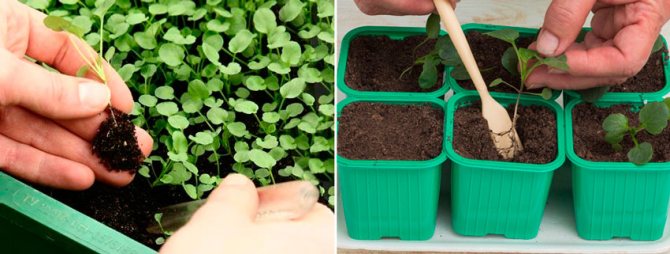

When exactly to make a pick and how many times? On this account, gardeners have 2 different opinions. So, one part of gardeners believes that it is necessary to dive these flowers a couple of times. In this case, the first pick is made after the appearance of 2 true leaves, and the second - after 15–20 days according to the 6x6 scheme. And another part of no less experienced gardeners believe that the second pick is completely unnecessary for this plant. It should be remembered that this plant can be planted on a site already flowering, while it will take root just as quickly and easily. The flowering of a plant grown from seeds is observed in late spring or early summer.
Soil preparation
Viola prefers to grow on fertile, permeable soil. Therefore, it is necessary to prepare the ground in advance. It can be purchased at a specialty store, but experienced flower growers prepare the soil themselves. To do this, they mix fertile soil, peat, humus.
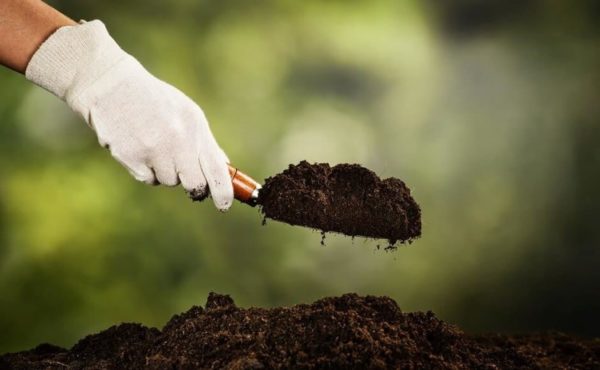

Advice!
You can grow seedlings in pure peat. This will also produce strong plants.
Before planting, it is necessary to decontaminate the soil and treat it with Fundazol. Immediately before sowing, the soil must be watered with a solution of potassium permanganate.
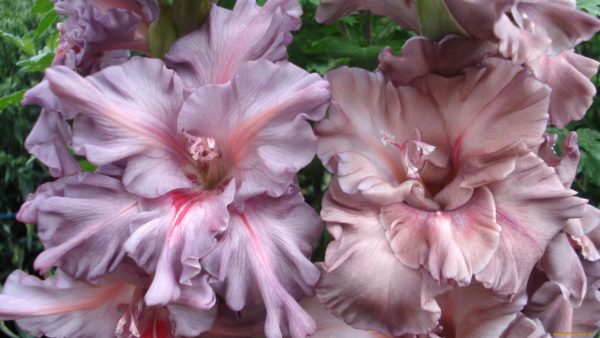

You may be interested in:
Children of gladioli: what to do with them Many flower growers do not know how to grow gladioli from children. Tubercuts are the best planting material… .Read more ...
Open ground transplant
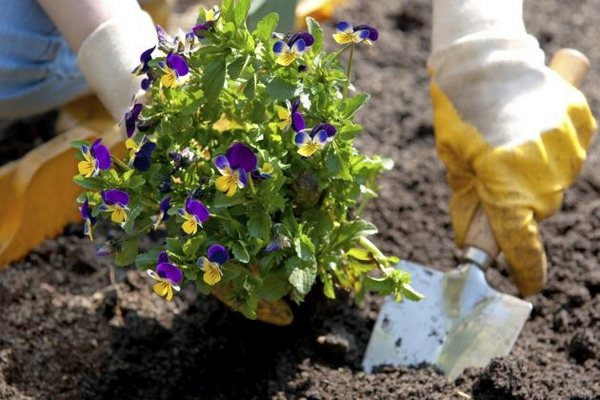

What time to plant viola
The time for planting seedlings in open soil directly depends on the climate in a particular area. So, the landing is carried out in April or in May. It is recommended to choose a well-lit area for the viola. It is best if the soil consists of earth, not very finely ground charcoal and dry bird droppings or humus (5: 1: 1). The following soil mixture is also suitable for the plant: sod land, sand, humus and peat (2: 1: 2: 2). Landing should not be carried out in a lowland where groundwater lies very close to the soil surface.
How to plant
Viola disembarkation is not difficult. First, the holes are prepared, while it should be borne in mind that a distance of 10 to 15 centimeters must be maintained between the bushes. The planted viols are sprinkled with soil, which should be tamped, and then watered. Perennial viols must be transplanted to a new place once every 3 years, while the bush is divided. If this is not done, then the flowers will grow strongly, and their flowers will begin to shrink. If you want to propagate a rare or favorite variety, then this can be done by cuttings.
Lunar landing dates
If you follow the recommendations of astrologers and engage in sowing work on suitable days, you will be able to get the maximum effect from the activity. When to sow seeds for seedlings, you can see in the table.
Table
| Month | Auspicious days | Bad days |
| January | 17-19, 23-27 | 5, 6, 21 |
| February | 6-8, 11-17, 23-25 | 4, 5, 19 |
| March | 12-17, 19-20 | 6, 7, 21 |
| April | 6-8, 11-13, 15-17, 29, 30 | 5, 19 |
| May | 8-17, 21-23, 26-28 | 5, 19 |
To get flowering bushes in May, you need to sow viola for seedlings in March. The lunar calendar will tell you when to start planting work. In it you can find information about favorable and unfavorable days. Based on the data received, it will be possible to develop an action plan and complete all procedures at the specified time.


You may be interested in:
Gatsania: growing from seed, when to plant Similar to chamomile, but different in gatsania color, it is African, both annual and perennial ... Read more ...
Care features


The root system of this flower is superficial and is located at a depth of 15 to 20 centimeters. In this regard, it is necessary that the soil is always slightly moist and loose. Watering is carried out only when there is a prolonged dry and hot period. If it rains regularly in summer, then you do not need to water the pansies. It is also necessary to pull out weeds in a timely manner and remove wilted flowers so that the flowering remains lush.
Also, these beautiful flowers need to be fertilized regularly. For this, 1 time in 4 weeks, feeding is performed with superphosphate or ammonium nitrate (from 25 to 30 grams of the substance is taken per 1 m2).
Diseases and pests


Taking care of the viola is quite simple, and if you strictly adhere to the rules and carry out all the necessary procedures on time (watering, weeding, loosening, feeding), then your flowers will always look incredibly impressive, and they will not get sick, and they will not be disturbed by harmful insects ... Often such a plant is sick with powdery mildew. In an infected specimen, a whitish or grayish bloom appears on the surface of leaf plates, buds and stems. Viola can get sick due to the fact that it is constantly fed with fertilizer containing nitrogen, and the disease can also be provoked by abundant dew in the morning in a relatively dry summer period. Diseased bushes must be treated with soda ash, to which you need to add foundation, soap or ground sulfur. In the event that the bush does not recover, then after half a month the treatment must be repeated.
Pansies can also get sick with a black leg or gray rot. The reasons for the development of these diseases are: inappropriate temperature conditions, violations of the moisture regime of the soil or air. Try to eliminate the cause of the disease, otherwise the rest of the bushes will become infected. Do not forget to dig up and destroy the infected plants, while you need to water the area where they grew with a solution of foundationol.
In some cases, this flower can get spotted. In an infected bush, the leaf plates begin to dry out, while the flower itself weakens. Be sure to dig up infected bushes. Experienced gardeners recommend burning them without fail so that the disease cannot spread further. The remaining healthy specimens should be subjected to preventive treatment. To do this, they need to be sprayed 2 or 3 times with Bordeaux liquid, while the intervals between treatments should be equal to 14 days.
A particular danger for this flower is the mother-of-pearl caterpillar of the violet and clover scoop, which feed on the leaves of this plant. In order to get rid of pests, plants should be treated with tobacco or chlorophos infusion.
Step-by-step instructions for sowing pansies for seedlings
Planting pansies for seedlings is a complex event in which it is important to perform each step correctly. Below is a detailed guide.
Soil preparation
Viola seedlings prefer nutritious, loose and permeable soil. You can buy soil (soil for violets) or do it yourself. If it is easier for you to buy a soil mixture, then add a little clean river sand before use.
To prepare soil for growing viola seedlings at home, mix the following ingredients:
- land from the garden or sod land (two parts);
- sand (one piece);
- peat (two parts);
- humus (two parts).
Or you can make a primer for pansies using the following recipe:
- turf land (two parts);
- humus (two parts).
- sand (two parts).
Important! The land for seedlings of pansies must be prepared before sowing (and it doesn't matter if you bought it or prepared it yourself). For disinfection, you should hold over steam or bake in the oven within 30 minutes. Then spill with phytosporin solution... And after that, be sure to sift.
Choice of capacity
The capacity for viola seedlings can be any, plants do not have strict preferences. You can choose a total wide and shallow container, for example, a box or some kind of rectangular bowl.
And you can put in individual containers - plastic cassettes, peat or plastic cups, peat tablets, homemade containers (milk or other food bags, tea bags).
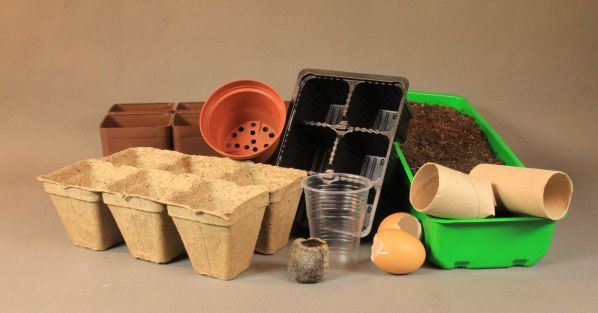

Selection and preparation of seeds
Viola seeds are, of course, best bought from reputable stores that have a great reputation and sell quality garden products. The package must contain all the detailed information: about the variety, sowing time, expiration date, etc. Choose the freshest seeds.
For better germination, it is recommended to prepare pansy seeds before sowing for seedlings... Prepare a solution of a stimulant drug, for example, "Epin", "Zircon", "Heteroauxin" or "Baikal Em-1", put the seeds in cheesecloth and immerse them in the solution. You need to prepare the solution according to the instructions for the drug.
Direct sowing of viola
So, you have waited for the optimal deadline, completed the preparatory activities, and now it's time to start the procedure itself. This instruction will help to sow the seeds of pansies:
- Place a 1 cm thick drainage layer on the bottom of the planting container. It is recommended to use small pieces of charcoal for this.
- Fill the container with soil.
- Moisten abundantly from a spray bottle with warm, settled water.
- Now you can sow viola seeds in 2 main ways:
- Embedded in the ground... In a custom container, use your finger or a pencil to make a 3-4 millimeter depression. In the general box, make grooves to the same depth, the gap between them is 2-3 cm. Put the seeds in rows, the distance between the seeds is 1-2 cm. Sprinkle with soil or sand on top. It is recommended to plant in this way.
- Surface sowing... Spread the seeds over the surface, the distance between them is 1-2 centimeters. If you have individual cups or cassettes, then you can put two or three seeds in them. You do not need to cover it with earth on top.
- Spray the soil surface again with a spray bottle.
- Now you need to create a mini greenhouse - cover with glass, lid or film.
By the way! You can sow with wooden stick or toothpick - you need to moisten one end in water, pick up the seed and brush it with the other stick on the surface of the soil. You can put seeds on folded sheet of paper and scatter over the surface of the soil. Or just plant with fingers or tweezers.
Planting viola in peat tablets
For many crops, peat tablets are chosen as the container.
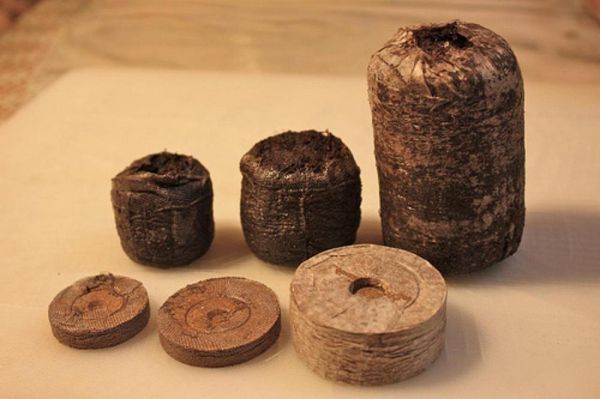

Plant pansy seeds correctlypeep peephole in peat tablets at home using the following technology:
- Pour warm water into the high-rimmed drip tray.
- Put the pills in there.
- Wait about 25-30 minutes for the tablets to swell, then drain the remaining moisture, if any.
- Pick up the seed with a toothpick or transfer it with your hands to the middle of the product.
- Slightly deepen the seed (no more than 2-3 millimeters).
- Spray from a spray bottle with warm, clean water.
- Cover the tray with tablets with a lid or film and place in a warm and dark place until germination.
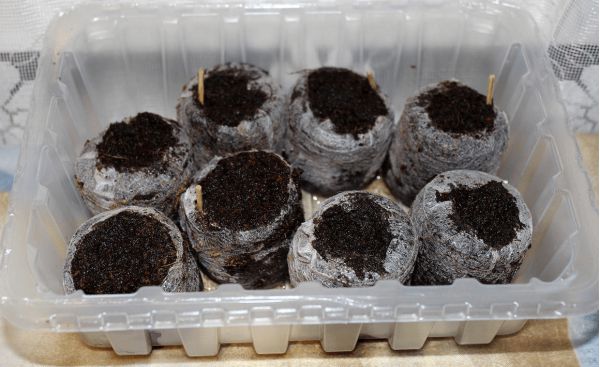

Viola after flowering
Seed collection
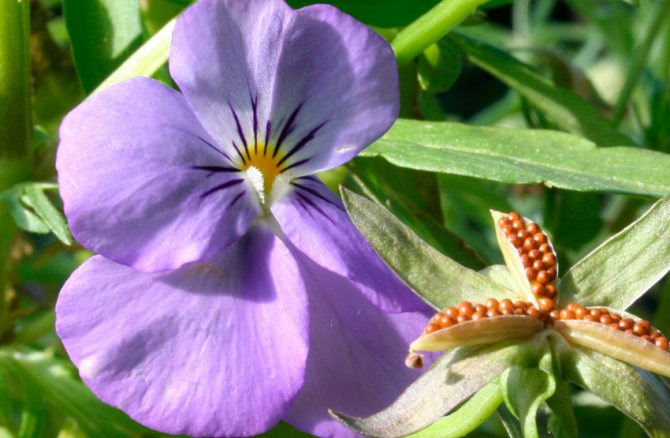

Collecting seeds should be done at the end of flowering, and this time is approximately in August or September. After the flower withers, a small box appears in its place, inside which there are seeds.It will be possible to start collecting seeds only after the box turns upwards. The extracted seeds must be sprinkled on a sheet of newspaper and dried in room conditions. Then they are put away on the refrigerator shelf, where they will be stored. In the event that the boxes with seeds are left on the bush, self-seeding will occur. Seedlings, as a rule, are dense, and the first plants may appear in autumn or spring. If you do not want to grow viola through seedlings, then simply thin out the seedlings in a timely manner, and also, if necessary, you can plant them.
Wintering
Modern varieties of viola, which are perennial plants, are highly frost-resistant. If they are covered with dry leaves or covered with spruce branches, they will calmly endure a drop in air temperature to minus 30 degrees. If you are growing annuals, then after flowering is over, they must be disposed of.
Varieties
The name "pansies" is carried by two varieties of violets - the already mentioned tricolor violet and a hybrid created on its basis - the Vittrock violet. They differ in appearance:
- Violet tricolor field Violet tricolor - has a thin, brownish and not too branching root. It grows to a height of 30-45 cm. In the wild, the petals are mostly blue or purple. Small brown and yellow seeds. The plant is used in medicines.
- Violet Wittrock unites many hybrid varieties under its name. The first hybrids appeared in the 18th century. The name of the variety was given in honor of Veit Wittrock, who studied these plants. Viola height - 15-40 cm, flower diameter up to 10 cm. Fibrous root system. Violet Wittrock is a thermophilic, and therefore an annual plant.
Nowadays, breeders have bred a considerable number of varieties of pansies, for every taste and color. Varieties are classified by flower size:
- Small ones. The diameter of the flower is on average up to 4 cm. The most popular small-flowered varieties: Blue Boy, White, Little Red Riding Hood.
- Large. Flowers from 4 to 6 cm. The following varieties are especially loved by gardeners: "Ice King", "Adonis", "Jupiter", "Evening Heat".
- Gigantic. More than 6 cm in diameter, bloom early. These include the "Swiss Giants" variety series.
Varieties are divided according to their appearance:
- Monochromatic - monochromatic, sometimes with small spots or stripes on the lower petals;
- Bicolor - when the upper and lower petals are painted in different colors;
- Spotted - characterized by contrasting spots.
Pansies come with even and uneven edges of the petals; bushes of different heights: low, medium and high; differ in flowering time.
The main types and varieties of viola with photos and names
Viola wittrockiana
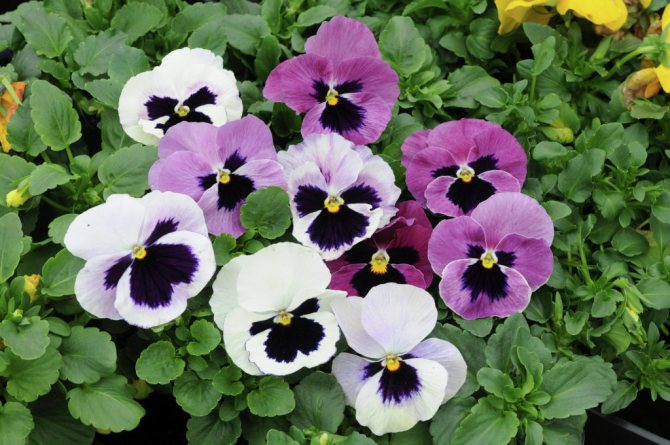

The most popular among gardeners is this particular species, which is also called pansies. This perennial plant is cultivated as a biennial. In height, the bush can reach from 20 to 30 centimeters. It has alternately arranged oval leaf plates, along the edge of which there are obtuse teeth. The flowers are single, relatively large (4–10 centimeters in diameter). They can be of different colors and shapes. Florists divide plants of this type into several categories: according to the timing and quality of flowering, according to the size of flowers, according to their color, shape and level of frost resistance. If the size of the flowers is taken into account, as well as their number on the bush during the flowering period, then the plants are divided into 2 groups: multi-flowered (multiflora) and large-flowered (grandiflora) varieties. If the color of the plant is taken into account, then in this case the varieties of such flowers are conventionally divided into: two-color, one-color, and also spotted. It should be remembered that the same variety can be both spotted and bicolor.
Single color varieties


- Viola White... The height of the spreading bush is 0.2 m, and its diameter is about 0.25 m. The leaf plates are green. The flowers are white, slightly yellow and green. They are very fragrant and are located on long peduncles. Flowering of this variety is observed from the second half of April to the first days of August and from the last days of September to October. It tolerates winter well under cover.
- Blue Boy... The height of the bush is about 0.25 m. The leaf plates are glaucous. The diameter of the ruffled bluish-lilac flowers is about 6 centimeters. The petals located on top are bent back. And also at the base of all the petals there are strokes of a dark lilac color. Up to 19 flowers can be opened on one bush at the same time. Bloom is observed from April to August and from September to October. Under cover it tolerates wintering well.
- Rua de Negri... The bushes are compact, they reach 0.23 m in height. There is a bluish bloom on the surface of the leaves. The flowers are five centimeters in diameter. Velvet petals are rounded, wavy along the edge, slightly bent back. At the base of the petal, located below, there is an eyelet of a rich yellow color. At the same time, up to 14 flowers can open on a bush. Flowering is observed in April – August, as well as in September – October. If the viola is covered, then it will well endure the winter.
- Viola red... Erect shoots reach 0.2 m in height. Red flowers have a diameter of about 7 centimeters, while at the base of the petals there is an eye of a very dark color.
Bicolor varieties
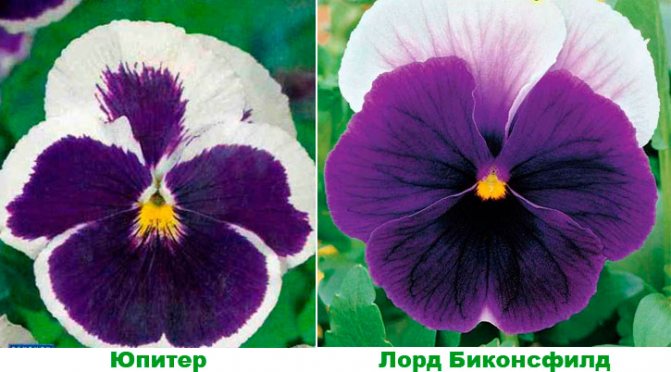

- Jupiter... A compact bush, reaching a height of 16 centimeters. The leaf plates are dark green. The diameter of the flowers is about 5 centimeters. Violet-white flowers have a rounded shape. The velvety petals on the bottom are dark purple, while those on the top are bent back and white at the base. Up to 20 flowers can open at the same time. Winter resistant.
- Lord Beaconsfield... The height of the bushes is about 25 centimeters. The leaf plates are slightly gray-gray. The diameter of the flowers is about 5.5 centimeters. The petals located below are dark purple with an uneven border along the edge of a lilac color. The upper bluish-white petals have ink strokes at the base. At the same time, about 30 flowers can open on a bush. The variety is frost-resistant.
- Saint Knud... On compact bushes, the height of which is about 0.2 m, there are green leaf plates. The diameter of the flowers is about 5 centimeters. Strongly protruding forward lower petals have a deep orange color, while at the base they are red. The petals located on top are pale orange-yellow in color. Up to 19 flowers can open on a bush at the same time.
Spotted varieties


- Shalom Purim. This is a several times improved form of the Viola Rococo variety. Her flowers are also double, but the petals are very strongly corrugated. The flowers are large (1/3 more than the standard). Sold in specialty stores as a mixture of seeds in a variety of colors. It also differs from the mother plant in that it grows better not in a sunny place, but in a small partial shade, in this case the petals will be the most corrugated.
- Hybrid F1 Tiger Eyes... This brand new hybrid has an amazing color. The flowers are small, they reach only 3 centimeters in diameter, on the surface of the yellow petals there are many thin streaks of brown. This plant is suitable for growing both outdoors and in a pot. The difference between this hybrid is that it blooms very early and luxuriantly, and its flowers have a pleasant smell.
- Hybrid F1 "Cassis"... The flowers, located on a compact bush, are purple in color and have a thin border around the edge of a white color.Flowering is very lush, it is characterized by increased winter hardiness.
Viola horned (Viola cornuta), or ampelous viola
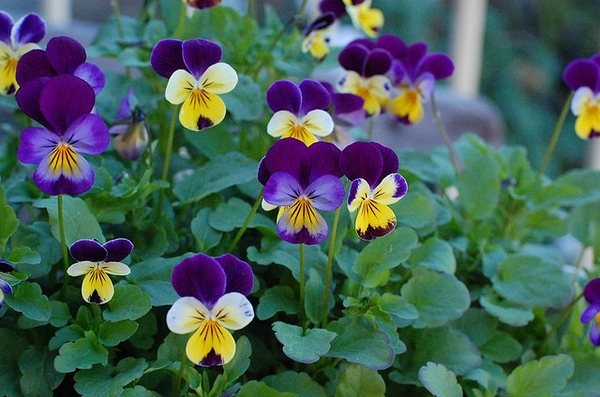

The ampelous viola is still quite popular among gardeners. The height of this perennial varies from 15 to 25 centimeters. The branchy rhizome is creeping, it grows and forms a carpet. The cross section of the shoots is triangular, oblong leaf plates are large-toothed, they reach about 6 centimeters in length. The stipules are pinnately incised. The bush has a huge number of flowers, in diameter they reach from 3 to 5 centimeters. They are painted in various shades of purple and lilac, they have a small yellow eye, and horn-shaped spurs. Flowering is observed in May – September. It has a high frost resistance, but it is recommended to cover it for the winter. It is necessary to grow ampel viola in almost the same way as garden viola. Breeders from England work most of all on obtaining new varieties of this species:
- Arkwright Ruby... This variety is large-flowered. The color of the petals is deep red, there is a yellow eye. On the base of the petals located below, there are specks of a dark color.
- Balmont Blue... The stems of the bush are climbing, and the color of the flowers is blue. Recommended to grow in both balcony containers and hanging baskets.
- Pearl Duet... The flowers have 2 petals, located on top, have a burgundy color, and the 3 lower ones are dark pink and have very dark streaks at the base.
Fragrant Viola (Viola odorata)
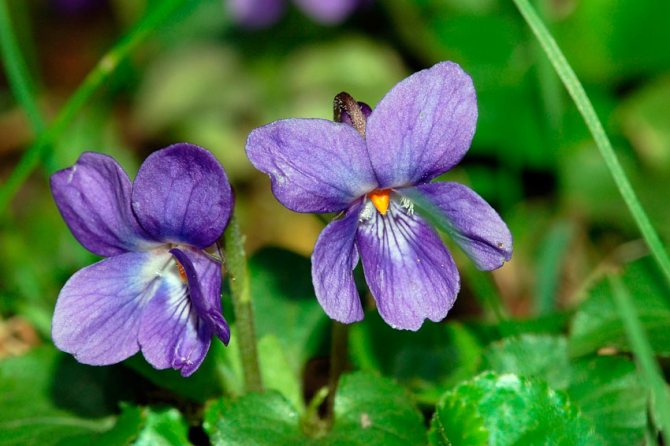

It is also quite often grown in gardens. This perennial plant has a thick rhizome. The length of the sheet plates, which have an almost round shape, is 9 centimeters, and the width is 8 centimeters. They are assembled into an outlet. The large, fragrant flowers are colored in various shades of purple. Flowering occurs in May and lasts 20 days. There are repeated blooms in autumn. Varieties:
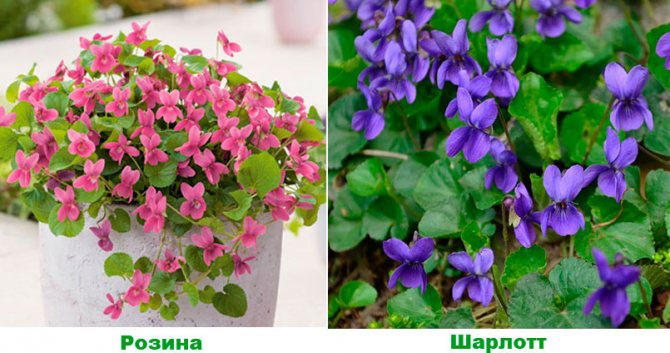

- Rosina... The flower is outwardly similar to a flying bird. Fragrant pink flowers are darker towards the base. The petals located on top are bent, and on the side they are slightly extended forward.
- Charlotte... The color of large flowers is dark purple.
- King... There are fragrant purple flowers.
Viola moth, or nodule (Viola papilionacea, Viola cucullata)
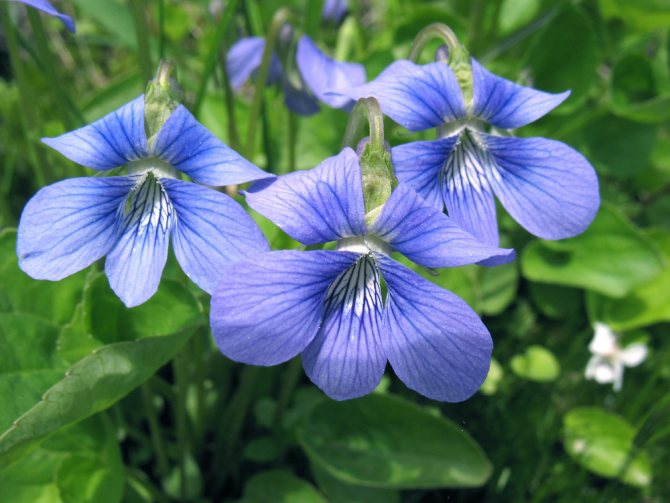

The height of the bush is from 15 to 20 centimeters. The leaf plates have a serrated edge and are reniform or heart-shaped. Large single flowers are colored purple. The petal located on top is white with a strip of purple color, their center is greenish-yellow almost white. Flowering is observed in April – June. Varieties:
- Freckles... White petals have many specks of purple color, if it is cool in spring, then they become larger. Flowering occurs in spring and ends early in the summer. Differs in unpretentiousness.
- Royal Robe... Miniature variety. The flowers are fragrant, their petals are bent back, at the base there are streaks of black or yellow. The color of the petals ranges from purple to violet-blue.
- Red Giant... Large purple-red flowers, located on long peduncles. Blooms for a very long time.
Also suitable for cultivation in the garden of viola: graceful, mountain, yellow, marsh, Altai, hairy, Labrador, single-flowered, variegated, sandy, somkhet, dog, sister, foot, amazing, hill and Selkirka viola. At the moment, they are used practically only by some breeders in their work.
Reproduction methods
Florists propagate viola in such ways.
Planting by cuttings
This method is especially important for breeding valuable varieties of viola, as it prevents the mixing of different varieties with each other.Propagating it by cuttings, you thereby rejuvenate the plant, because starting from the third year, it grows strongly, and at the same time there are fewer flowers and they are smaller. Plus, this method allows you to collect a lot of material for planting in just one season. For example, one flower is capable of producing up to 45 cuttings, which is almost fifty future violas!
Cuttings can be carried out from May to July. Even those plants that are in the flowering phase will do. In order for the grafting process to be successful, you need to adhere to the following tips:
- First of all, you should choose a suitable place where the viola stalks will be planted. Trees are best suited for shade and moisture.
- Having decided, they dig up a small bed and water it abundantly with water.
- Following this, suitable cuttings are selected on an adult plant and carefully cut. You need to use only green apical shoots, on which two or three nodes have already formed.
- Next, the cuttings are planted on a bed, while deepening them into the ground by half a centimeter.
- The cuttings should be very tightly together, so that their leaves touch each other.
- To avoid wilting and to help take root faster, the seedlings are covered with a damp cloth (or paper).
The next few weeks, the care is not difficult - you just need to water and weed the young plantings every day, and after three to four weeks your work will begin to bear the first fruits - almost all the cuttings will take root.
If you want the viola to bloom in the same year, then cuttings should be carried out in May-June.
With later cuttings, flowering should be expected next spring. But on the other hand, it will be much more abundant than in the previous version!
Once the cuttings are rooted, they can be transplanted to a permanent growing area and taken care of. In the case of late cuttings, it is better not to transfer young plants to flower beds, but leave them to winter, covering them with foliage.
Seed propagation
This process depends on what kind of viola you want to get.
If it is an annual plant that should bloom in the same year, then the seeds should be sown in containers or greenhouses in early March. Such seedlings will bloom in June.
When grown as a biennial plant, sow immediately after the seeds are ripe. For this purpose, you also need to equip a special bed. You already know how to do this.
Seedlings will appear after two to three weeks. Two weeks later, when 2-3 true leaves appear, the seedlings need to be dived, and already in late summer - early autumn, young plants can be planted in a permanent place of growth. And already at the beginning of spring next year, you can enjoy the beautifully blooming viola.
Grow viola in your flower garden, and then a good mood and smiles will not keep you waiting!
Diseases and pests
Violas are threatened by common garden pests such as aphid or a spider mite. Get rid of them by washing with water and spraying with chlorophos or other similar preparations.
Powdery mildew
Diseases, as a rule, indicate improper cultivation, the main prevention is control over watering and disinfection of the soil.
The most common misfortune is powdery mildew, manifested by a white bloom on leaves or stems. Solutions of soda with soap and foundazol help against it.
In case of illness black leg or gray rot, it is urgent to transplant healthy plants, remove diseased plants to prevent the spread of infection, and disinfect the soil.
In general, pansies are really unpretentious, it is not difficult to take care of them.

